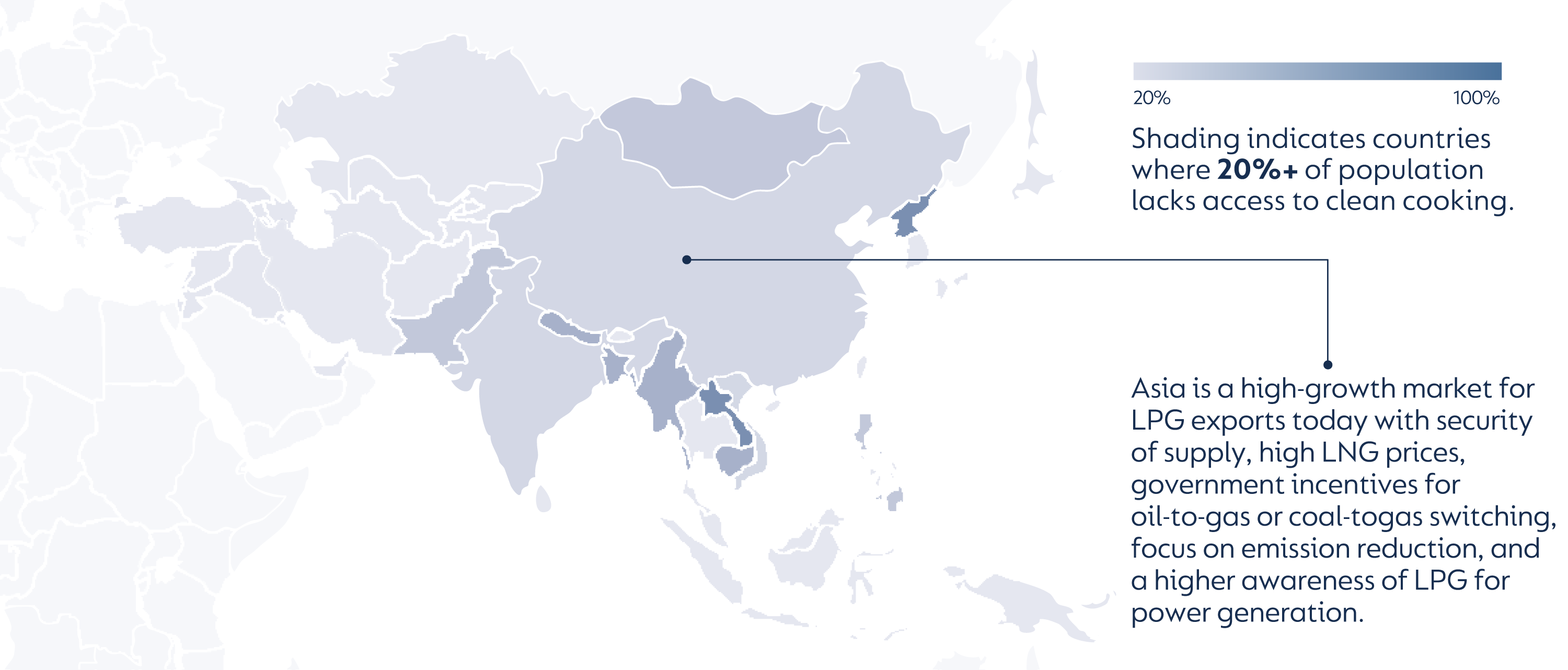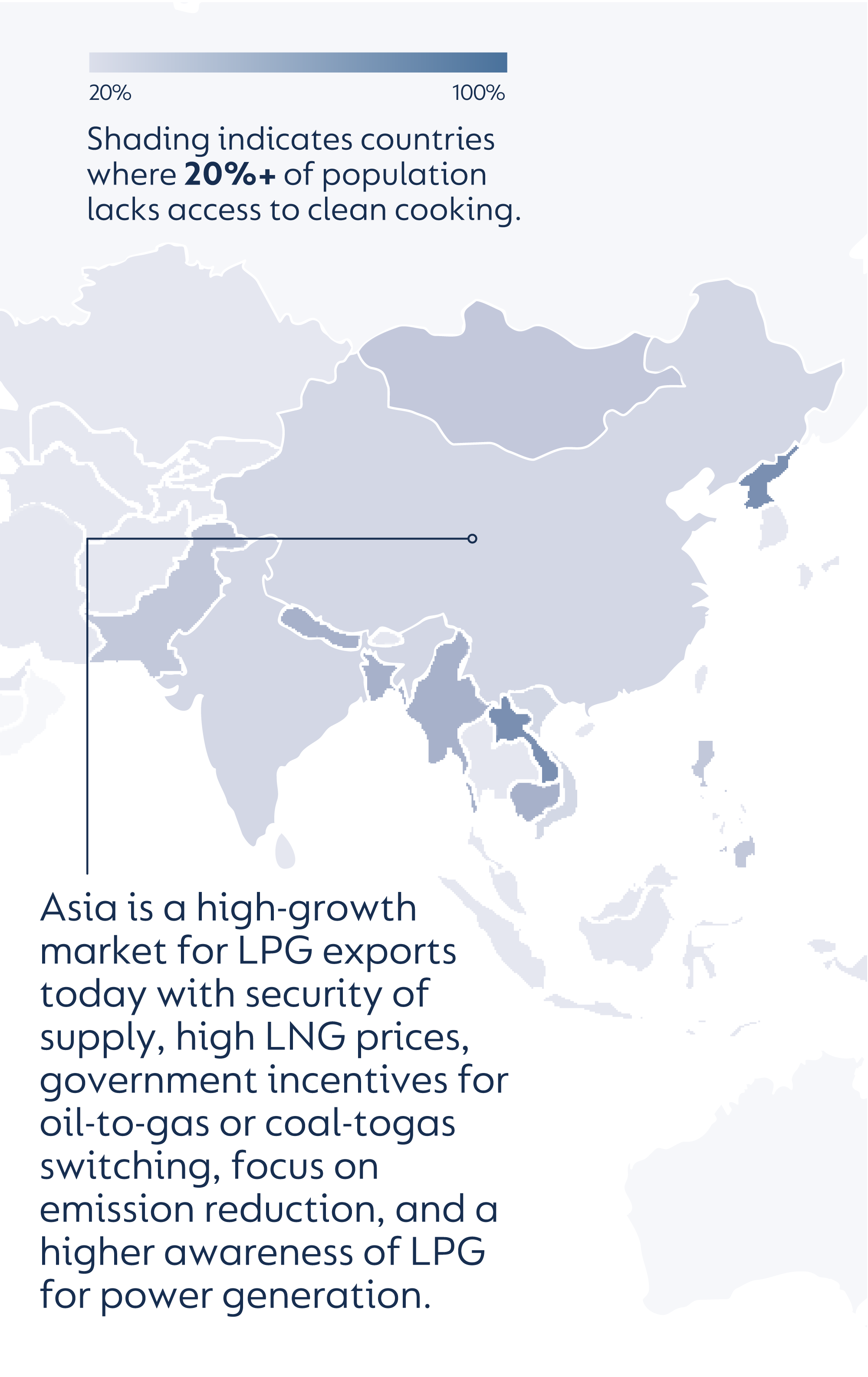What is LPG?
LPG is a by-product of oil & natural gas production and refining. It is a clean burning energy source recognised for its transportability and ease of use relative to alternative forms of stand-alone energy.
LPG use falls into three broad categories:
- Residential and commercial applications
- Industrial applications
- Agricultural uses
In the residential and commercial markets, LPG is used primarily for cooking, space heating, and water heating. Industrial customers typically use LPG in the production process (in kilns, furnaces etc.) and to power engines and propel vehicles such as warehouse forklifts.
Agricultural users consume LPG to dry crops, rear poultry, and control weeds among other applications.
LPG is normally transported and stored in a liquid state under moderate pressure or refrigeration for ease of handling in shipping and distribution.
When the pressure is released or the temperature increased, LPG becomes a flammable gas that is colourless and odourless, although an odorant is added to allow its detection. Propane is non-toxic, clean-burning and, when consumed, produces virtually no particulate matter or sulphur dioxide (significant contributors to climate change).
LPG is a by-product of oil & natural gas production and refining.
LPG consists of propane and butane and is extracted during the oil refining process or the natural gas production process.
Normally transported and stored in liquid state under moderate pressure or refrigeration for ease of handling in shipping and distribution.
LPG’s pivotal role in the energy transition
LPG is a cleaner-burning fuel that can help meet energy needs while addressing concerns on climate change
~60% carbon reduction by substituting wood for LPG
~35% less CO2 emitted by LPG than coal, on a Btu basis
Adoption of LPG will decrease household air pollution
Over 1/3 of the world population lack access to clean cooking, primarily relying on biomass – contributes to ~4m premature deaths each year
Substituting LPG for wood will avoid deforestation
51% of annual global net deforestation can be saved by converting 268m households to LPG
LPG growth driven by government incentives and health benefits


LPG benefits societies
LPG in its many applications contributes directly to four Sustainable Development Goals
Providing reliable access to energy
LPG is a viable energy source in remote areas, requiring little to no infrastructure
Easy access to a safe and quick source of energy
In many cultures, people walk 20+ km carrying 20+ kg wood for cooking and spend 20+ hours per week gathering wood – all avoidable by instead using LPG as fuel, freeing up time and improving people’s health as a result of lower emissions when burning LPG compared to wood
Facilitating societal development and mobility
Reliable access to electrical energy, freeing up time from cooking and reducing diseases enable societies to educate, improve and prosper
Improving diets by safe processing and disinfection
With fuel scarcity, diets can be obliged to shift to higher consumption of less nutritious but faster cooking foods, increasing risks of infectious disease transmission due to insufficiently cooked food and improperly boiled water
LPG in its many applications contributes directly to four Sustainable Development Goals
Providing reliable access to energy
LPG is a viable energy source in remote areas, requiring little to no infrastructure
Easy access to a safe and quick source of energy
In many cultures, people walk 20+ km carrying 20+ kg wood for cooking and spend 20+ hours per week gathering wood – all avoidable by instead using LPG as fuel, freeing up time and improving people’s health as a result of lower emissions when burning LPG compared to wood
Facilitating societal development and mobility
Reliable access to electrical energy, freeing up time from cooking and reducing diseases enable societies to educate, improve and prosper
Improving diets by safe processing and disinfection
With fuel scarcity, diets can be obliged to shift to higher consumption of less nutritious but faster cooking foods, increasing risks of infectious disease transmission due to insufficiently cooked food and improperly boiled water
(Source: www.wlpga.org)
LPG is a cleaner alternative to bio-mass energy
0.8-2.0 billion people will switch from traditional cooking with wood to other fuels (such as LPG) between 2015-2030. If all 1.2 billion people switched to LPG, this would imply:
A reduction in CO2 emissions of 170 – 415 million tonnes per year
Equivalent to the emissions of the Netherlands or United Kingdom respectively
Prevention of 0.8 – 2.0 million hectares of deforestation per year
Equivalent to 16 – 40% of current deforestation globally
Clean burning, capable of reducing the 4.3m annual deaths from air pollution
Indoor air pollution is the tenth leading cause of avoidable deaths, responsible for 7.7% of global mortality
LPG generates about 1/5 of the carbon of wood per unit of delivered cooking heat
LPG transfers 50% of its energy content to the pot, compared to wood’s 10-20%
Annual per capita cooking requires 43kg of LPG instead of 400kg of wood
Reducing the amount of transportation, further reducing emissions
0.8-2.0 billion people will switch from traditional cooking with wood to other fuels (such as LPG) between 2015-2030. If all 1.2 billion people switched to LPG, this would imply:
A reduction in CO2 emissions of 170 – 415 million tonnes per year
Equivalent to the emissions of the Netherlands or United Kingdom respectively
Prevention of 0.8 – 2.0 million hectares of deforestation per year
Equivalent to 16 – 40% of current deforestation globally
Clean burning, capable of reducing the 4.3m annual deaths from air pollution
Indoor air pollution is the tenth leading cause of avoidable deaths, responsible for 7.7% of global mortality
LPG generates about 1/5 of the carbon of wood per unit of delivered cooking heat
LPG transfers 50% of its energy content to the pot, compared to wood’s 10-20%
Annual per capita cooking requires 43kg of LPG instead of 400kg of wood
Reducing the amount of transportation, further reducing emissions
(Source: www.wlpga.org)





